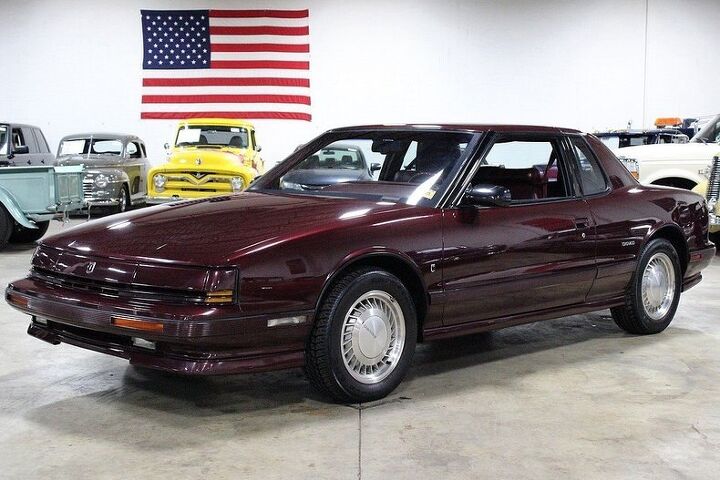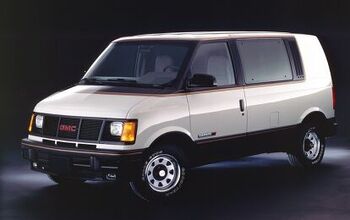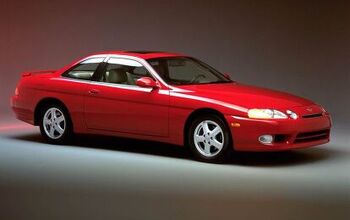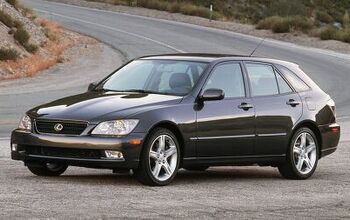QOTD: Can You Build an Ideal Crapwagon Garage? (Part VI: SUVs)

In our creatively organized Crapwagon Garage, we’ve seen varied body styles like wagons and trucks. Today we’re going to pick out some truckwagons, which you may know as SUVs.
Let’s pick out four or five four-by-fours for cheap.
But first, I’ve perused last week’s coupe comments for the Forgotten Gem Award:
An easy choice, and one I should’ve remembered. It’s Ajla’s number one selection, the 1992 Oldsmobile Toronado Trofeo. At over 200 inches in length, the full-size final Toronado featured flip-up headlamps and an interior full of CRT digital goodness. They’re hard to find in good condition, but it can certainly be done. And it’s sure to always run, as it is blessed by GM 3800.
Time for today’s SUVs, so let’s look at the rules:
- A crapwagon must be a vehicle which is relatively easy to find and purchase using an internet.
- All vehicles in the crapwagon garage must have been sold as new, in the North American market.
- Said vehicles must be obtainable to the casual crapwagon collector (CCC). This means in clean, running condition each one asks $7,000 or less on a normal day.
- Your suggestions must fit into the vehicle category of the week. If you don’t like the category, that’s tough. We’ll get to a category you like eventually.
- There are five rules to this garage game, and that’s the maximum number of vehicles you may submit for each section. Just five.
In order to be considered an SUV, a vehicle must have a rear cargo area covered by a roof, and a vertical liftgate or swinging rear door. For our purposes, it must also have been offered with either all-wheel drive or four-wheel drive. Vehicles with sliding side doors do not qualify as SUVs. My first pick was an easy one.
It’s the first generation Lexus LX450. A thinly-broughamed inline-six Land Cruiser which was always loaded with options, it usually featured gold badges and two-tone paint. Just as capable as its Toyota brother, it came from a time when luxury SUVs outside of the Range Rover were still an experiment. Well-heeled owners hung onto these, and they’re not too hard to find in great condition.
Here’s my second choice, the final North American Mitsubishi Montero from 2006. Comfortable and capable, it had the veneer of luxury Mitsubishi thought necessary to compete with other luxury truck offerings of the time. It’s just as well, since Mitsubishi had the gall to ask $47,000 for the Montero Limited. Most of these have been beat up, and people like Gtem tell me that parts aren’t the easiest to find — but that doesn’t stop my Montero desire. Special nod to the simply gigantic glass sunroof present on all models without rear DVD player. I’d find the cleanest one I could, and it would still be within budget.
Let’s hear your SUV Crapwagon Garage picks.
[Images: JLR, sellers, Lexus]

Interested in lots of cars and their various historical contexts. Started writing articles for TTAC in late 2016, when my first posts were QOTDs. From there I started a few new series like Rare Rides, Buy/Drive/Burn, Abandoned History, and most recently Rare Rides Icons. Operating from a home base in Cincinnati, Ohio, a relative auto journalist dead zone. Many of my articles are prompted by something I'll see on social media that sparks my interest and causes me to research. Finding articles and information from the early days of the internet and beyond that covers the little details lost to time: trim packages, color and wheel choices, interior fabrics. Beyond those, I'm fascinated by automotive industry experiments, both failures and successes. Lately I've taken an interest in AI, and generating "what if" type images for car models long dead. Reincarnating a modern Toyota Paseo, Lincoln Mark IX, or Isuzu Trooper through a text prompt is fun. Fun to post them on Twitter too, and watch people overreact. To that end, the social media I use most is Twitter, @CoreyLewis86. I also contribute pieces for Forbes Wheels and Forbes Home.
More by Corey Lewis
Latest Car Reviews
Read moreLatest Product Reviews
Read moreRecent Comments
- Jalop1991 In a manner similar to PHEV being the correct answer, I declare RPVs to be the correct answer here.We're doing it with certain aircraft; why not with cars on the ground, using hardware and tools like Telsa's "FSD" or GM's "SuperCruise" as the base?Take the local Uber driver out of the car, and put him in a professional centralized environment from where he drives me around. The system and the individual car can have awareness as well as gates, but he's responsible for the driving.Put the tech into my car, and let me buy it as needed. I need someone else to drive me home; hit the button and voila, I've hired a driver for the moment. I don't want to drive 11 hours to my vacation spot; hire the remote pilot for that. When I get there, I have my car and he's still at his normal location, piloting cars for other people.The system would allow for driver rest period, like what's required for truckers, so I might end up with multiple people driving me to the coast. I don't care. And they don't have to be physically with me, therefore they can be way cheaper.Charge taxi-type per-mile rates. For long drives, offer per-trip rates. Offer subscriptions, including miles/hours. Whatever.(And for grins, dress the remote pilots all as Johnnie.)Start this out with big rigs. Take the trucker away from the long haul driving, and let him be there for emergencies and the short haul parts of the trip.And in a manner similar to PHEVs being discredited, I fully expect to be razzed for this brilliant idea (not unlike how Alan Kay wasn't recognized until many many years later for his Dynabook vision).
- B-BodyBuick84 Not afraid of AV's as I highly doubt they will ever be %100 viable for our roads. Stop-and-go downtown city or rush hour highway traffic? I can see that, but otherwise there's simply too many variables. Bad weather conditions, faded road lines or markings, reflective surfaces with glare, etc. There's also the issue of cultural norms. About a decade ago there was actually an online test called 'The Morality Machine' one could do online where you were in control of an AV and choose what action to take when a crash was inevitable. I think something like 2.5 million people across the world participated? For example, do you hit and most likely kill the elderly couple strolling across the crosswalk or crash the vehicle into a cement barrier and almost certainly cause the death of the vehicle occupants? What if it's a parent and child? In N. America 98% of people choose to hit the elderly couple and save themselves while in Asia, the exact opposite happened where 98% choose to hit the parent and child. Why? Cultural differences. Asia puts a lot of emphasis on respecting their elderly while N. America has a culture of 'save/ protect the children'. Are these AV's going to respect that culture? Is a VW Jetta or Buick Envision AV going to have different programming depending on whether it's sold in Canada or Taiwan? how's that going to effect legislation and legal battles when a crash inevitibly does happen? These are the true barriers to mass AV adoption, and in the 10 years since that test came out, there has been zero answers or progress on this matter. So no, I'm not afraid of AV's simply because with the exception of a few specific situations, most avenues are going to prove to be a dead-end for automakers.
- Mike Bradley Autonomous cars were developed in Silicon Valley. For new products there, the standard business plan is to put a barely-functioning product on the market right away and wait for the early-adopter customers to find the flaws. That's exactly what's happened. Detroit's plan is pretty much the opposite, but Detroit isn't developing this product. That's why dealers, for instance, haven't been trained in the cars.
- Dartman https://apnews.com/article/artificial-intelligence-fighter-jets-air-force-6a1100c96a73ca9b7f41cbd6a2753fdaAutonomous/Ai is here now. The question is implementation and acceptance.
- FreedMike If Dodge were smart - and I don't think they are - they'd spend their money refreshing and reworking the Durango (which I think is entering model year 3,221), versus going down the same "stuff 'em full of motor and give 'em cool new paint options" path. That's the approach they used with the Charger and Challenger, and both those models are dead. The Durango is still a strong product in a strong market; why not keep it fresher?





































Comments
Join the conversation
I'm gonna cry foul on the Land Cruiser idea. In Portland and Seattle, after deducting non-running examples, obvious spam bait, and "for parts only," you have something on the order of ten vehicles total to pick from. All high miles and with issues. The "Toyota Tax" lives. On the European front, the two candidates (Land Rover and Mercedes) have potential repairs waiting for you far in excess of that $7000 price point. Not no, but he** noes. So... a Chevy Tahoe (or it's GMC counterpart) would work great, as would a Jeep Cherokee. If you could find one that hasn't been hooned to within inches of it's life. I'd recommend a Bronco, but I already own one of those. A pristine example will come closer (or over) you price point than you'd believe possible. But they don't know what a rust-free 25 yr old truck looks like east of the Rockies.
*searching furiously if the 4-door Niva was sold in NA or not* no, saad :( any GMT900 platform then... ugly to look at, outperformed in each and every way by the orientals and even Ford.